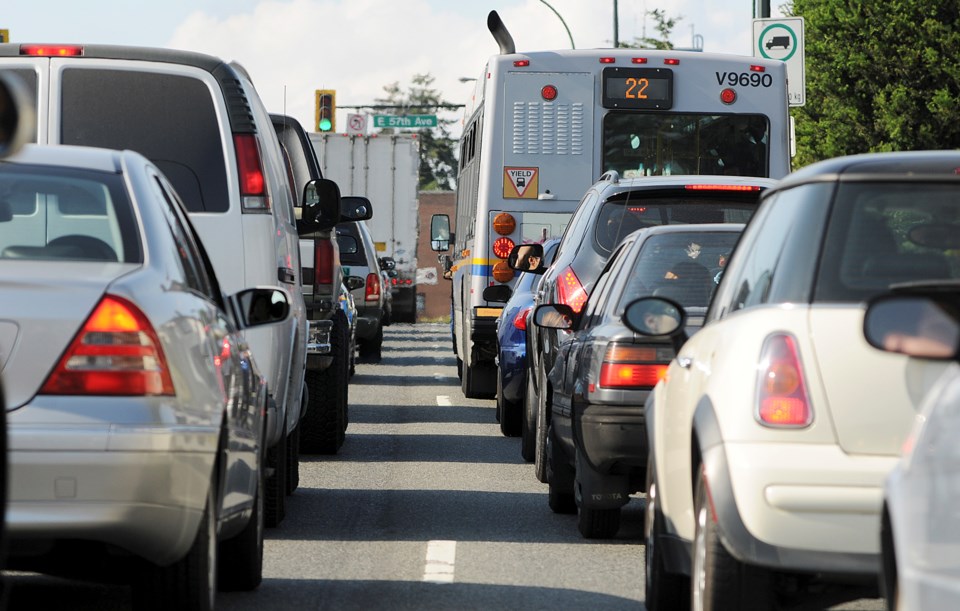Over the past two weeks, driving in Metro �鶹��ýӳ��has been the way I used to remember it. Getting around to appointments or shopping destinations, or even up to the North Shore mountains for some recreation has been a breeze.
I have often arrived ahead of schedule.
Even though the Christmas break usually ends after New Year’s Day, my commutes to work this week have been calm affairs. So what has become of our city that suddenly getting around in a vehicle seems far less stressful?
Well, I hate to break it to you, but starting on Monday that bumper-to-bumper experience is coming back. That is because our kids are going back to school Jan. 8 after an extended break.
And whether we care to admit it, we spend a lot of time ferrying kids to and from school in our cars. A study of traffic in Greater Toronto found the number of children and teens walking or biking to school has declined to the point that school travel is now responsible for 20 per cent of peak morning gridlock in that region, and it is no different here.
It is amazing to think that one in five drivers on the road during your morning commute could be taxiing kids to school.
The study also indicated that just 39 per cent of 11- to 13-year-olds walked to school in 2011, compared to 56 per cent in 1986. And only 12 per cent of kids that age got a car ride to school in 1986; now 31 per cent do. Those trends are probably not going to get better over time.
Try to get near almost any school in your vehicle around 8:30 a.m. or past 3 p.m. and you will see how much we have come to rely upon cars for getting to and from classes. I’m just as guilty of it myself, shuttling my daughter to and from her out-of-catchment high school a few days of the week.
This is in spite of personally promoting walk-to-school initiatives in the past.
In case you doubt my assertion, the holiday break over Christmas and Boxing Day are not the only times we see this big dip in traffic. It happens again over the summer months of July and August when schools are closed. Traffic reports on the high impact of back-to-school drivers are now an annual occurrence.
Our politicians usually take it on the chin when drivers get frustrated by traffic. We complain — sometimes loudly and often on social media — about how aggravating it is to get around here. We blame street repair projects and construction for the slow downs. Rarely do we discuss other sources of the high traffic volumes.
There are other long-term impacts on society thanks to driving kids to school, such as lower fitness levels and higher obesity among adults. Children who walk or bike to school are typically more active, and active children tend to become active adults.
You cannot blame parents for wanting to make sure their kids get safely to school. But paradoxically, they are creating potentially less safe streets around school zones. There are plenty of reports from school districts around the world where road rage around schools has led to honking, cursing and fender benders.
One city — Manchester, England — even tried flexible school times to deal with the gridlock, probably not expecting the backlash they got from parents and the teachers’ union.
In response to the local study, Toronto city planner Jennifer Keesmaat said getting children to walk to school could have a greater impact than any “big-vision, billion dollar schemes.”
“We need to rebuild the culture around walking,” Keesmaat said. “It’s a much more profound infrastructure investment than any roads or subway we can build.”
Indeed, my observation is that in spite of the growing concern about school-related gridlock, school boards make only half-hearted attempts to encourage walking or cycling. They can be forgiven for not shouldering the entire burden, however.
Our municipal governments and local health authorities have a big role to play in supporting that “culture” change through collaborations to promote active transportation and improve the pedestrian experience.
Through these new efforts we could conceivably save billions on health and infrastructure spending, and enjoy a life less burdened by traffic gridlock.



